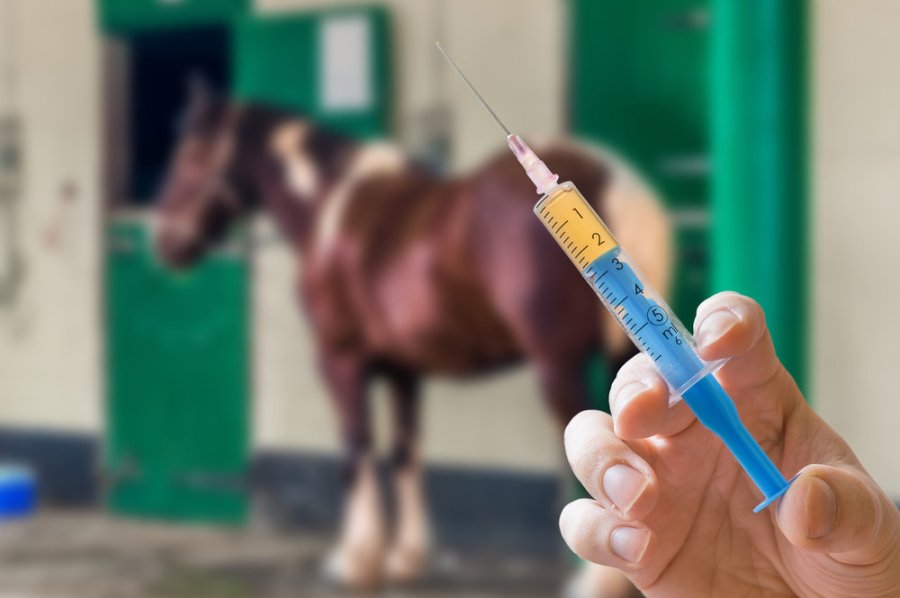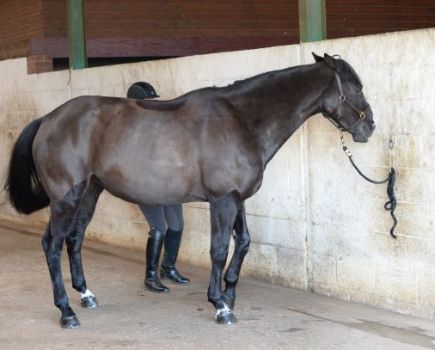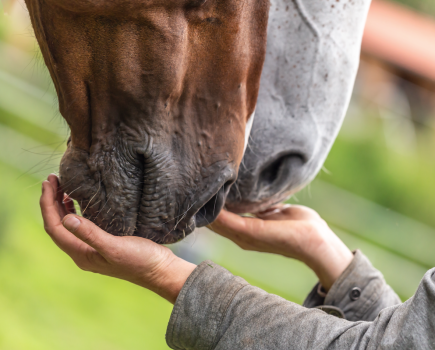Tetanus, also termed lockjaw, is a devastating neurological disorder that causes muscle paralysis in horses. Around 75% of infected horses will die, so ensuring you are aware of the signs and keeping your horse up to date with their tetanus vaccination is imperative for your horse’s health.
Tetanus was first described more than 3,000 years ago in Egypt and is caused by toxins. The main toxin is tetanospasmin, which is produced by the bacterium Clostridium tetani. This is found primarily in spore form and is a common soil organism. Tetanus toxin binds irreversibly to nerve endings causing spastic or rigid muscle paralysis.
Clinical disease of tetanus in horses generally occurs following the contamination of a wound with Clostridium tetani spores. In some cases, the wound may already have closed up and the horse owner may be oblivious to it having been there.
While most cases of this deadly disease will occur within nine days of the horse suffering a wound, there have been some reports of tetanus striking months following injury. Other likely sites of infection include puncture wounds affecting the sole of the foot, injection site abscesses, the uterus in postpartum mares and the umbilicus in foals, to name but a few.
Signs a horse has tetanus
Clinical signs of tetanus vary depending on the stage of the disease, the dose of toxin and the immune status of the horse in question. An early tell-tale sign is the temporary protrusion of the third eyelid.
Signs subsequently progress to rigidity of the head and neck muscles, with affected horses developing paralysis of the muscles they use to chew and open their mouths, hence tetanus’ other name — ‘lockjaw’.
A sufferer may also have what looks like an anxious facial expression, may stand with their head and neck outstretched, and will be unwilling to lower their head to the ground. The third eyelid also prolapses during this phase. A low-grade fever may be present too.
In mildly affected horses, clinical signs may be limited to the above, but in more severely affected equines paralysis extends to other muscles in the body and rigid extension of the limbs, body and tail may be seen.
Affected horses will show a ‘saw-horse’, trestle-like stance, a stiff gait and the tail-head may be elevated. Hyper-responsiveness is another classical sign of tetanus, with sufferers demonstrating an exaggerated and often dramatic response to external stimuli, such as to noise.
These most severe cases progress to the horse lying down, with death following due to paralysis of the muscles involved in breathing. In horses who succumb to the disease, death generally occurs within seven days of the first clinical signs. Severely affected horses, especially those not getting up, should be euthanised to prevent further unnecessary suffering.
Diagnosis by a vet is based on the clinical signs, recent wound history and a lack of vaccination.
Treating tetanus in a horse
Treating a horse for tetanus should involve:
- Providing a quiet, dark and safe environment in addition to adequate supportive care.
- Eliminating tetanus toxin which hasn’t attached to nerve endings through the administration of tetanus anti-toxin.
- Sedation and muscle relaxation.
As horses with tetanus are likely to be in a hyper-reactive state, as part of their treatment plan the quiet, dark place they are stabled in should serve to remove any unnecessary stimulation. This stable should have a deep bed in case the horse wants to lie down.
If the horse is still eating and drinking, feed and water should be offered from a height so that they don’t have to bend their neck unnecessarily. In moderate to severe cases, if the affected horse is unable to eat and/ or swallow, intravenous fluid therapy with or without additional nutritional support will be given.
If the source of infection is through a recent wound, this should be cleaned and the damaged tissue removed. Tetanus anti-toxin may be administered into the tissues surrounding the wound to neutralise the toxin.
This tetanus anti-toxin should also be given intravenously, intramuscularly, or subcutaneously for three to five days to neutralise further unattached toxin. The vet will also start antibiotic drug therapy, probably metronidazole. Sedatives and muscle relaxants may be used to alleviate muscle spasm. These are painful and so pain relief should be provided.
With 75% of infected horses dying of tetanus, factors associated with mortality include a fast incubation time, entry via the uterus in a mare, via the umbilical cord in foals, and a lack of adequate vaccination. Horses who recover generally stabilise within the first week, but they may take months to reach full health.
Tetanus: prevention tips
Vaccination is highly effective in protecting a horse against tetanus. Due to the success of vaccination programmes, the incidence of clinical disease is fortunately very low in developed countries.
The vaccine itself, which is a toxoid vaccination (i.e. made up of the germ that causes the disease), is relatively inexpensive. In horses over six months of age, a primary course consists of two vaccinations administered intra-muscularly four weeks apart.
Adequate immunity should be obtained two weeks after the second vaccination. The horse’s first booster vaccination should be administered 17 months after this second vaccination and at the very least every other year after that.
Foals are at increased risk of infection if they are born to mares who haven’t been immunised, as are those who have consumed insufficient quantities of colostrum. In these cases, tetanus anti-toxin should be administered at birth. These foals should also receive an additional tetanus vaccination at four months of age, in addition to the primary vaccination course at six months.
Wounds in unvaccinated horses
If your horse sustains a wound and their tetanus vaccinations aren’t up to date, you must contact your vet to arrange a visit so that they can give them tetanus anti-toxin. This provides emergency cover for tetanus and immunity will last for 14-21 days.
Such horses should also receive a tetanus vaccination at the same time, and they should be booked in to start their primary vaccination course four weeks later.
The current equine vaccination only offers protection for two years once the primary vaccination course is complete, which is why boosters are given at regular intervals.
Case study: a critical patient
When I met a nine-year-old Thoroughbred who had become unwilling to come in from her field, I was told that her tetanus vaccinations lapsed. The mare’s behaviour occurred around five days after she had sustained a leg wound.
On examination, she showed an increased heart rate and temperature and she was unwilling to move forward. There was no heat in her feet, or increase in her digital pulses, making laminitis a less likely, although not impossible, scenario.
The mare’s leg wound had become infected and she had diffuse cellulitis of the affected limb, which was painful on palpation. I prescribed antibiotics, anti-inflammatories and tetanus anti-toxin.
The mare was moved indoors, albeit with difficulty, to allow a more thorough examination and to enable ongoing treatment. At this point it was unclear whether her clinical signs were purely related to the cellulitis or whether something else was going on.
Once she was examined inside, it became clear that the horse’s third eyelid was protruding and that she had become unwilling to lower her head to the ground to eat.
Over the next few hours her symptoms progressed rapidly as she displayed general stiffness and the lameness in her cellulitic limb. The clinical signs became ever more suggestive of tetanus and, thinking about it with hindsight, she had probably been unwilling to move in the first instance due to the tetanus rather than her cellulitic limb.
The stable environment was kept dark and quiet, and I gave her fluids intravenously. Her leg wound was cleaned, but within hours of lying down she was unable to get up and had to be euthanised.
Vaccination is essential
I strongly recommend that every horse is vaccinated for protection against tetanus and that you keep on top of regular boosters. It really could save your horse’s life.
You should also consider having your horse vaccinated against equine influenza, whether they go out competing or not.
Lead image: copyright Shutterstock








